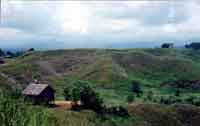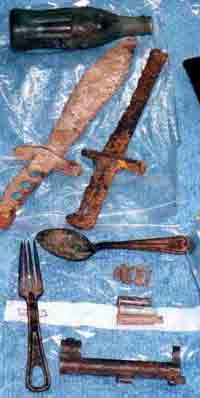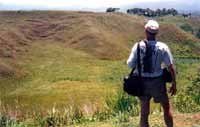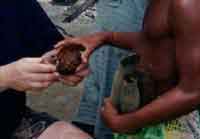Peter Flahavin Visit to Edson's Ridge
|
January 1995 / February 1996 Peter Flahavin / Rod Bellars When I first went here in 1995, I only had a basic idea of the battle, but I have read a lot more since then. A lot of the surrounding jungle has been cut back since 1975 and some huts have gone up there since 1992. In 1995-96 we walked the ground and found cartridge cases, belt clips, a single .45 calibre bullet, a US 2 cent piece and a Japanese helmet with a bullet hole near Marine Para positions on the left flank of the ridge. We were offered a US Army dogtag marked to “Edwin W. Geiger”. In 1999 I received a letter from Florida letting me know he was still alive and that he remembered losing his dogtag. He was a member of the 247th Field Artillery Battalion, Americal Division. He was a 2nd Lieutenant. The forward slope is still covered in barbed wire and stakes , so you had to watch your step. The kids had empty cartridge cases, cutlery , mess tins, US 37mm cases and canister round anti-personnel steel balls . The villagers said after periodic burning off items come to light. One guy showed us the remains of a Springfield rifle barrel bent like a bow by the force of an explosion. On this first ridge is a Japanese memorial dedicated to peace and the soldiers of both nations who fought here. In 1995 a 40 minute walk into the jungle south of the ridge brought us to the tail section of a shot down Betty bomber . As we walked back to the foot of the ridge there was the tail fin with paint and markings intact lying against a tree - red primer paint with two horizontal white stripes and the number “3”...obviously carried out and on its way to being stolen by parties unknown . We alerted the museum and they were back there two hours later - but too late. It had been filched in the meantime by “two white men in truck.”, which really did not impress them , especially after I had shown them the video footage I took of it shortly before . They said that is a problem - aircraft parts etc being stolen and shipped out of the country to overseas collectors. In 1996 a friend asked to be taken to the tail section we had told him about, but when they got to the site the whole tail was now gone, so somebody has been busy - he was not impressed after the long walk! It would have taken some effort to get it all out of there. Interestingly he showed me a photo he had taken in the nearby bushes where a chunk of cut up metal with a white “3” was lying... a bit of the tail we saw or another part of the plane? He found a few other smaller aircraft bits in grass near the ridge and some well marked parts of US mortar ammunition containers. In 1996 the tall grass that was in front of the final Marine positions in 1995 had been burnt off, so we were able to have a look there. The trench indentations were visible and the barbed wire stakes and wire still there too - one near full roll was lying where it had been dumped partially strung - almost a frozen moment in time. We walked down the slope and about 15 feet in front of the position there was the remains of a jerrican and nearby a yellow painted US pineapple grenade lying half buried in the dirt - very nice but live . I had read that the infantry disliked the bright yellow paint on the early issue grenades, but I was glad it made this one more visible! A villager then walked over with a mint (live) Japanese grenade that he had found only the day before in his garden in the side of the hill , about 10 feet from the crest . From this point it is only a 15 minute walk to the airfield - they sure got close . The Japanese soldier who threw it must have been excited ,as he had not activated it - it probably cost him his life to get it up there too. Both these were handed in for disposal . (Whenever we walked a battle site and were offered any relics we made sure to warn the locals of the dangers of unexploded ordnance - the Solomons bomb disposal squad periodically collect ordnance and blow it at Lunga Point) . On this final defensive knoll there is an American memorial near the site of Col. Edson’s command post. Return to Peter Flahavin Main Page
|





